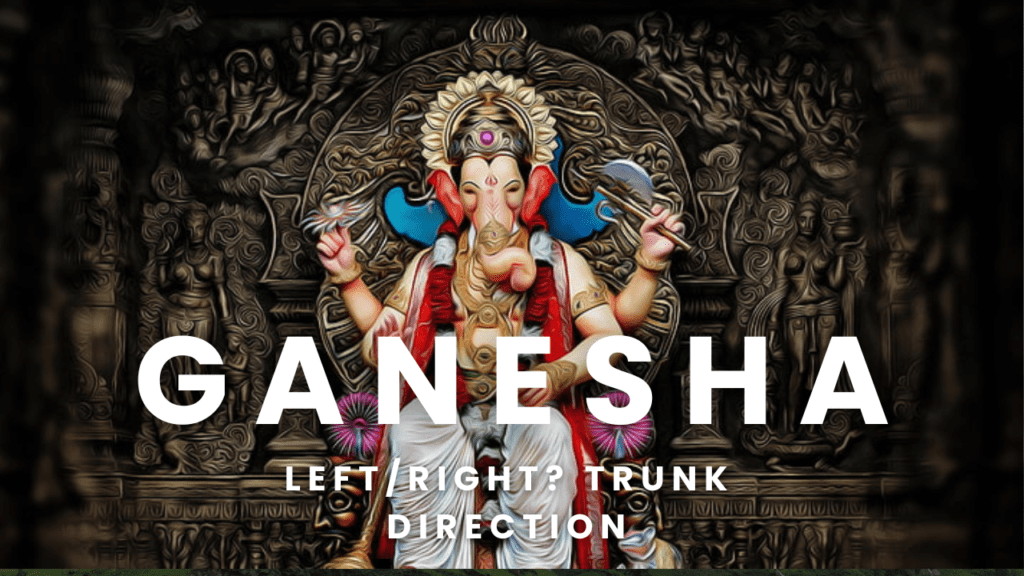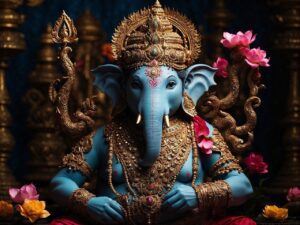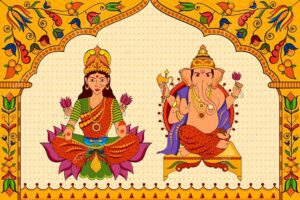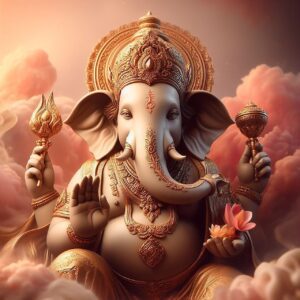Do you know, choosing whether to have a Ganesha idol with its trunk facing left or right can influence the energy flow in your home! Let’s discuss the right Ganesha’s trunk direction for your home.

Left or Right? What’s the right Ganesha’s trunk direction for your home?
Millions have a deep place in their hearts for the adored elephant-headed god Ganesha. The elephant God is known as the remover of obstacles and a blesses his devotees with good fortune. His presence is sought in homes and businesses. In India, Ganesha is often worshipped before commencing important tasks and businesses. But did you know that the direction of Ganesha’s trunk carries deep symbolism? This small element can impact your life’s journey and the ambiance of your living area. This article will explore the meaning behind Ganesha’s trunk position and discover which direction might be ideal for your home.
The Significance of Ganesha’s Trunk Direction
All the idols of Lord Ganesha, whether with a left or right-facing trunk, are considered highly auspicious. However, there are differences between Vamamukhi and Dakshinamukhi.
Left-Facing Trunk (Vamamukhi):
When Ganesha’s trunk is directed towards his left, it is known as Vamamukhi. This orientation is considered highly auspicious and is believed to attract happiness, success, and prosperity into the home. This side of Ganesha’s trunk is linked with feminine energy or moon. Vamamukhi Ganesha idols are worshipped for peace and prosperity.
It can enhance the overall well-being of the household and bring about a harmonious environment. It is believed that the left side corresponds with feminine energy or Shakti. This connection emphasizes fertility and prosperity within one’s home environment.
Right-Facing Trunk (Dakshinamukhi):
- Symbolism: A right-facing trunk, or Dakshinamukhi, is less favorable according to Vastu principles.
- Avoidance: It is generally advised to avoid placing a Ganesha idol with a right-facing trunk in the home, as it may not contribute to the desired positive outcomes.
The right-facing trunk symbolizes active masculine energy. The right-facing trunk is symbolic of the sun, and its fiery nature.
Worshipping a right-facing trunk Ganesha involves strict adherence to rituals and practices. This is due to the belief that the right trunk is more potent and demanding, necessitating a greater degree of purity and devotion from its devotees. This is the only reason that Ganesha’s idol with right facing trunk should not be kept at home.
Moreover, Dakshinamukhi Ganesha are often worshipped by advance Yogis and Siddhas as right-facing trunk of Ganesha is associated with the attainment of Nirvana, the ultimate state of liberation and spiritual enlightenment in Hinduism. If worshipped, it is believed to bring rapid and significant changes in the worshiper’s life.
Usually, Dakshinamukhi Ganesha idols are installed at temples and large places because such intense energy can’t be handled in a small place like a home or a room.
Cultural Beliefs and Examples
There are different beliefs regarding Ganesha’s trunk direction in different regions of India. Some regions consider left facing trunk over right facing trunk, and vice versa. While most of the temples have Daskshinamukhi Ganesha, there are also some renowned temples featuring Ganesha with a left trunk.

One of the most renowned temples featuring Ganesha with a left trunk is the Siddhivinayak Temple in Mumbai. This sacred place attracts thousands of devotees daily, who believe that praying to this representation brings immense blessings and prosperity.
Another significant temple is the Ganesh Temple at Kashi Vishwanath in Varanasi. Here, Ganesha’s left-trunk posture symbolizes wealth and success, making it a favored spot for seekers hoping to enhance their fortunes.
In South India, the Pillayar Pattu Temple showcases an exquisite statue of Ganesha with his trunk gracefully turned left. Devotees flock here during festivals, seeking guidance and abundance from this magnificent deity.
These temples not only hold religious importance but also serve as cultural hubs where tradition intertwines with spiritual reverence. Each visit offers a unique experience steeped in centuries-old beliefs about prosperity linked to Ganesha’s left-facing trunk.
Factors to Consider When Choosing a Ganesha Statue for Your Home
Choosing the right Ganesha statue for your home involves several personal factors. Think about your beliefs and what resonates with you spiritually.

Ultimately, choosing the ideal Ganesha statue involves balancing tradition, symbolism, and personal resonance. As you invite this beloved deity into your surroundings, may his presence bring blessings tailored specifically for you.
Ganesha’s trunk direction and idol may influence how you feel about prosperity, protection, or harmony. You can consider:
- Consider the materials used in the statue. Whether it’s wood, stone, or metal, each material carries its own energy and significance. Choose one that aligns with your home’s aesthetic as well.
- Size matters too; a large statue can become a focal point while smaller ones fit nicely on shelves or altars.
- Placement is essential in Vastu Shastra; ensure it complements the flow of energy within your space.
- According to Vastu Shastra, the ancient Indian science of architecture and design, the Ganesha idol should be placed in the north, east, or west direction of the house. The northeast corner, known as Ishan Kona, is particularly beneficial.
- It is important to avoid placing the Ganesha idol in the south direction, as it is believed to attract negative energy and obstacles.
- Consider the posture of Ganesha. Different postures (e.g., sitting, standing, dancing) and symbolic elements (e.g., the position of the trunk, the objects held in his hands) can have different meanings and significance. For instance, a left-facing trunk (Vamamukhi) is considered auspicious for removing obstacles and bringing prosperity.
- The color of the statue can also be significant. Different colors may represent different aspects of Ganesha’s attributes. For example, red is often associated with energy and passion, while white symbolizes purity and peace.
- Consider where the statue will be placed in your home. It should be in a quiet, clean, and respectful area. Avoid placing it in areas that are prone to disturbances or pollution.
Vastu for Ganesha Idol at your Home
In many households, Ganesha idols are placed with great reverence to invite positive vibes. However, did you know that there are specific guidelines related to Vastu for positioning these idols? The Ganesha’s trunk direction plays a crucial role in optimizing spiritual energy within your home.

In Vastu Shastra, placing a Ganesha idol can enhance harmony and remove obstacles. His presence promotes peace among family members while attracting auspicious energies. The trunk direction of Ganesha matters too—ideally positioned to the left invites success and abundance. When correctly placed, this sacred figure acts as a guardian against negativity.
Avoid placing him directly in line with a toilet or bathroom. Such positions might disrupt the flow of energy, which can lead to challenges in life. Another ideal spot is on a raised platform or altar, preferably in the living area or study room. This empowers his presence and creates an inviting atmosphere for blessings.
Consider using natural light around the idol; it brings warmth and serenity to your worship space. Positioning him near plants also engages nature’s energy, enhancing tranquility further. Remember, ensure that his trunk faces left to attract wealth and abundance effortlessly into your home.
Also Read: 5 Biggest Hanuman Statues in India
Common Mistakes to Avoid in Placing Ganesha at Home
- Consider Ganesha with trunk facing left over right. Ganesha’s trunk direction changes the energy of a space.
- Placing a Ganesha idol at home requires careful thought. One common mistake is positioning the idol against a wall. This can create a negative energy flow, disrupting harmony in your space.
- Another error is placing the idol in cluttered areas. Keep the surrounding area tidy to invite positivity.
- Avoid facing Ganesha towards any exit or door. Instead, he should face inward, symbolizing prosperity and abundance flowing into your life.
- Many overlook lighting as well. Proper illumination around the idol elevates its presence, creating an inviting atmosphere for worship and reflection.
- Never place Ganesha in bathrooms or near toilets. Such placements can hinder spiritual growth and attract negativity into your home environment.
Incorporating these practices establishes a sacred connection with Lord Ganesha while aligning your home with harmonious energies that promote overall well-being.
Conclusion
Choosing the right Ganesha statue for your home involves careful consideration of several factors, including material, size, placement, style, budget, and care.

Ganesha’s trunk direction and the placement of his idol in your home are essential aspects of Vastu Shastra. By following these guidelines, you can create a harmonious and prosperous living environment. Remember, a left-facing trunk (Vamamukhi) is considered the most auspicious, and placing the idol in the north, east, or west directions can further enhance the positive energy in your home.
By incorporating these principles, you can invite the blessings of Lord Ganesha, ensuring a smooth and successful life for you and your family.
Also Read: Favourite flowers of Lord Ganesha







